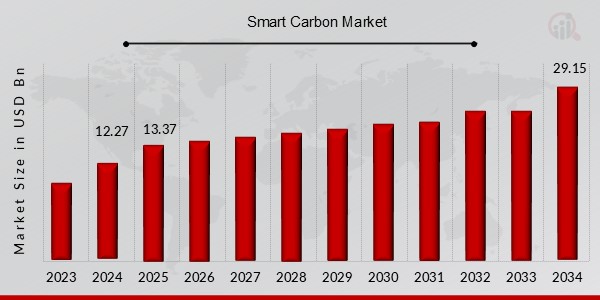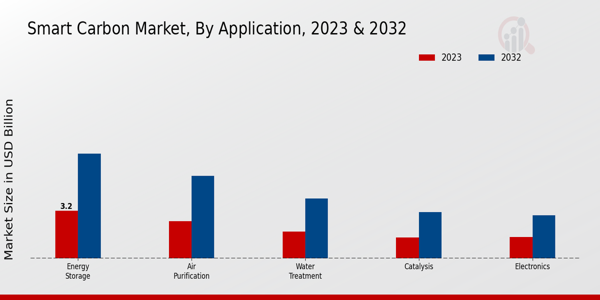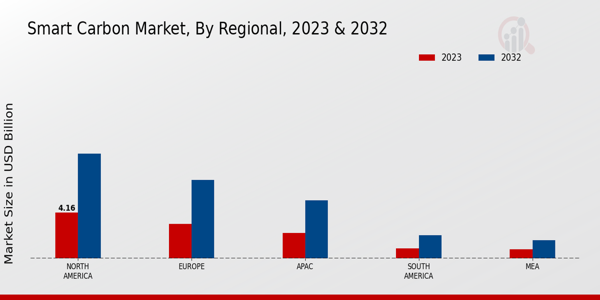Global Smart Carbon Market Overview
The Smart Carbon Market Size was estimated at 12.27 (USD Billion) in 2024. Smart Carbon Industry is expected to grow from 13.37 (USD Billion) in 2025 to 29.15 (USD Billion) by 2034, at a CAGR (growth rate) is expected to be around 9.00% during the forecast period (2025 - 2034)
Key Smart Carbon Market Trends Highlighted
The Smart Carbon Market is evolving rapidly due to several key market drivers. Increasing demand for sustainable energy solutions, coupled with government initiatives supporting carbon capture technologies, is propelling market growth.
Innovations in carbon management systems that enhance efficiency and reduce emissions are transforming how industries approach carbon sustainability. Additionally, a rising awareness of climate change and its impact is compelling businesses to invest in smart carbon solutions.
The automotive, manufacturing, and energy sectors are particularly focused on integrating these technologies to lower their carbon footprint while meeting regulatory requirements.
Opportunities to be explored in this market are vast. Companies can leverage advancements in artificial intelligence and IoT to develop smarter carbon management systems that optimize resource usage.
The integration of these technologies can lead to significant cost savings and improved operational efficiency. Furthermore, emerging markets are increasingly prioritizing sustainable practices, creating avenues for growth in smart carbon solutions.
Collaboration between technology providers and traditional industries can foster innovative applications that capture and utilize carbon more effectively. Trends in recent times show a shift towards circular economy practices, where carbon recycling and reuse are becoming essential components.
Organizations are now prioritizing transparency in their carbon accounting, which aligns with consumer demand for responsible business practices. Policymakers are also implementing stricter regulations aimed at reducing carbon emissions, prompting businesses to adopt smarter carbon strategies.
As these trends continue to evolve, the synergy between technology and sustainable practices will play a crucial role in shaping the future of the smart carbon market. Overall, the combination of market drivers, opportunities, and recent trends indicates a transformative phase for the industry, making it a pivotal area for investment and innovation.

Source: Primary Research, Secondary Research, MRFR Database and Analyst Review
Smart Carbon Market Drivers
Growing Demand for Carbon Reduction Technologies
The rise in temperatures and climate change challenges has led to increased awareness and demand for innovative solutions to reduce carbon emissions. This growing concern is driving industries and governments worldwide to invest in carbon reduction technologies.
The Smart Carbon Market is witnessing a surge in interest from organizations that aim to comply with stricter environmental regulations and corporate sustainability goals. As stakeholders recognize the importance of reducing their carbon footprint, the adoption of smart carbon solutions is expected to gain momentum.
Factors such as recent advancements in carbon capture and storage technologies, along with the development of smart materials that can sequester carbon more effectively, are further propelling this trend. Furthermore, public and private initiatives that advocate for a low-carbon economy are expected to create significant opportunities for the Smart Carbon Market.
With a focus on achieving net-zero emissions by mid-century, various sectors, including energy, transportation, and manufacturing, are increasingly prioritizing carbon reduction strategies, thus driving the growth of the smart carbon market.
Government Initiatives and Support
Governments around the globe are intensifying their efforts to promote sustainable practices and reduce carbon emissions, which is significantly influencing the Smart Carbon Market.
Numerous countries have implemented policies and regulations that incentivize the development and adoption of smart carbon solutions. These initiatives often include funding for research and development, tax incentives for companies adopting carbon-neutral technologies, and the establishment of carbon trading systems.
Such support from governments not only fosters innovation but also encourages collaboration between the public and private sectors, creating a more conducive environment for the growth of the smart carbon market. As nations aim to meet international climate agreements, the backing of governmental initiatives will be crucial in accelerating advancements in carbon management technologies.
Increased Investment in Sustainable Technologies
There is a noticeable uptrend in investment in sustainable technologies and practices, driven by both private and institutional investors.
The Smart Carbon Market stands to benefit greatly from this influx of capital as innovative technologies that focus on carbon management are being prioritized. Investors are increasingly seeking projects that promote sustainability and align with environmental, social, and governance (ESG) criteria.
This growing focus on sustainable investment not only provides the necessary funds for research and development but also encourages companies to innovate continually.
Furthermore, as the financial sector begins to factor climate risks into investment strategies, businesses that participate in the smart carbon market are likely to see enhanced access to funding opportunities, propelling the industry's growth further.
Smart Carbon Market Segment Insights:
Smart Carbon Market Application Insights
Within this expansive market, the application segment plays a critical role, characterized by diverse domains such as Energy Storage, Air Purification, Water Treatment, Catalysis, and Electronics.
Among these applications, Energy Storage held a majority share, valued at 3.2 USD billion in 2023 and projected to reach 7.0 USD billion in 2032. This segment's significance stems from the increasing demand for efficient energy solutions, particularly in renewable energy systems where smart carbon materials facilitate enhanced storage capabilities.
Following closely was the Air Purification application, valued at 2.5 USD billion in 2023, with anticipated growth to 5.5 USD billion by 2032. The rising concern over air quality and pollution drove this segment, highlighting the essential role of smart carbon in providing innovative purification solutions.
The Water Treatment segment demonstrated a steady valuation of 1.8 USD billion in 2023 and is expected to grow to 4.0 USD billion by 2032, emphasizing the growing importance of clean water access and the advanced filtration techniques offered by smart carbon materials.
In the Catalysis domain, the market was valued at 1.4 USD billion and is projected to develop further to 3.1 USD billion by 2032, underlining the pivotal role of catalytically active smart carbon in industrial processes, which require effective catalysts for chemical reactions.
Lastly, the Electronics application, valued at 1.42 USD billion in 2023 and expected to reach 2.9 USD billion in 2032, showcased the increasing adoption of smart carbon technologies in electronic devices, offering enhanced performance and miniaturization capabilities.
The Smart Carbon Market data emphasizes a well-segmented landscape where each application contributes distinct advantages and meets significant societal challenges, driven by technological advancements and market growth opportunities.
The interplay between these applications and the overall market dynamics underscores the extensive relevance of the smart carbon industry in addressing contemporary environmental and energy challenges while providing profound insights into the future direction of the market.

Source: Primary Research, Secondary Research, MRFR Database and Analyst Review
Smart Carbon Market Type Insights
It is classified into several types, each serving unique applications and industries. Activated Carbon holds a crucial role in this market, widely utilized in environmental applications for air and water purification, showcasing its significant demand.
Carbon Nanotubes, known for their exceptional electrical and mechanical properties, are driving advancements in electronics and materials science, marking their importance in sectors like nanotechnology.
Graphene, another critical type, is valued for its remarkable conductivity and strength, finding applications in energy storage and advanced composites, which enhances its prominence in the market. Carbon Black, extensively used in the production of tires and plastics, continues to dominate due to its crucial role in enhancing performance characteristics.
Lastly, Biochar contributes to agricultural sustainability and carbon sequestration, revealing its growing significance in environmental applications. The diversity in the Smart Carbon Market segmentation reflects the industry's adaptability and innovation, presenting numerous growth opportunities influenced by evolving technological trends and increasing environmental awareness.
Smart Carbon Market End Use Insights
Industrial applications are pivotal, reflecting the increasing integration of carbon solutions for improved productivity and sustainability in manufacturing processes.
Residential usage has gained traction as consumers lean towards eco-friendly technologies, promoting energy efficiency and reduced carbon footprints. Moreover, the commercial sector is significant, driven by the demand for smart solutions that enhance building management systems and optimize resource consumption.
The Smart Carbon Market segmentation highlights the importance of each area, with industrial applications likely holding a majority share due to ongoing advancements.
Overall, these segments are crucial for transforming operational practices and addressing environmental challenges, which contributes to market growth and evolving trends, ultimately influencing Smart Carbon Market revenue and statistics in the years ahead.
Smart Carbon Market Functionality Insights
The segment is characterized by its key areas such as Adsorption, Conductivity Enhancement, Strengthening, and Chemical Reactivity. Adsorption plays a critical role in filtration and environmental applications, providing effective solutions for pollutant removal.
Conductivity Enhancement is increasingly sought after in energy storage and electronic components, enhancing performance and efficiency. Strengthening functionalities are vital in materials science, bringing improvements to structural integrity and durability.
Meanwhile, Chemical Reactivity opens new avenues in catalysis and chemical processes, driving innovation in sustainable solutions. The trends within the Smart Carbon Market segmentation suggest a robust growth trajectory fueled by rising awareness of environmental issues and the need for advanced material properties.
Such functionalities are becoming essential for various industries, making this segment a focal point for market growth as businesses adopt smart carbon solutions to address contemporary challenges. The anticipated increase in market size to 22.5 USD billion by 2032 demonstrates the underlying potential and attractiveness of the functionalities offered by smart carbon materials.
Smart Carbon Market Regional Insights
North America emerged as the largest contributor, valued at 4.16 USD billion, representing a majority holding and dominating due to its advanced technology infrastructure and strong investments in sustainable solutions.
Following closely was Europe, valued at 3.12 USD billion, which highlights its commitment to green initiatives and strict regulatory frameworks driving market growth. The APAC region, valued at 2.3 USD billion, is witnessing rapid industrialization and increasing demand for smart solutions, positioning it as a vital area for future expansion.
South America and MEA, valued at 0.92 USD billion and 0.82 USD billion, respectively, represented emerging markets with considerable growth potential, although they currently play a smaller role in the overall Smart Carbon Market revenue.
These dynamics illustrate the diverse opportunities and challenges present within each region, emphasizing the need for tailored strategies to address varying market demands and regulations. Market growth in these regions is further propelled by rising awareness of carbon management and sustainable practices, creating an array of opportunities for stakeholders in the Smart Carbon Market.

Source: Primary Research, Secondary Research, MRFR Database and Analyst Review
Smart Carbon Market Key Players and Competitive Insights:
The Smart Carbon Market is witnessing significant growth as organizations increasingly focus on sustainability and reducing their carbon footprints.
This market comprises various players specializing in technologies and services aimed at carbon management, energy efficiency, and smart grid solutions. The adoption of smart carbon management solutions is driven by regulatory pressures, rising energy costs, and the need for businesses to enhance their environmental credentials.
In a competitive landscape characterized by rapid innovation and collaboration, companies are racing to develop advanced solutions that cater to diverse industry needs, fostering an environment where strategic partnerships, acquisitions, and technological advancements play critical roles.
As companies navigate this dynamic market, understanding competitors' strengths, weaknesses, and market positioning will be essential for seizing growth opportunities and achieving a sustainable competitive advantage.
In the Smart Carbon Market, Schneider Electric stands out due to its comprehensive portfolio of energy management and automation solutions. The company's commitment to sustainability and innovation enables it to offer advanced products that optimize energy consumption, improve operational efficiency, and facilitate effective carbon management.
Schneider Electric leverages its extensive expertise in automation and analytics to provide clients with insights into their energy usage, helping them to make informed decisions that align with their sustainability goals.
This position gives Schneider Electric a strong market presence as it fosters collaborations with other organizations and invests in research and development to enhance its offerings continuously.
The combination of a robust brand reputation and a focus on eco-friendly practices positions Schneider Electric favorably in a competitive landscape where businesses are increasingly prioritizing carbon reduction strategies.
On the other hand, Microsoft is making significant strides in the Smart Carbon Market through its cloud-based solutions and technological initiatives aimed at sustainability. The company's Azure platform plays a crucial role in providing businesses with powerful tools for data analytics and carbon footprint measurement.
By leveraging artificial intelligence and advanced analytics, Microsoft enables organizations to gain insights into their carbon emissions and identify areas for improvement. Additionally, Microsoft has committed to becoming carbon-negative by 2030, demonstrating its dedication to reducing environmental impact and advancing sustainable practices.
This strong corporate commitment, alongside its technological capabilities, positions Microsoft as a formidable player in the smart carbon landscape, helping businesses develop their sustainability strategies while benefiting from cutting-edge technology and data-driven decision-making processes.
Key Companies in the Smart Carbon Market Include:
-
Schneider Electric
-
Microsoft
-
Honeywell
-
Tesla
-
Climeworks
-
Occidental Petroleum
-
LanzaTech
-
TotalEnergies
-
Drax Group
-
ABB
-
Siemens
-
CarbonCure Technologies
-
Carbon Clean Solutions
-
General Electric
-
C3.ai
Smart Carbon Market Developments
Recent developments in the Smart Carbon Market showcase a growing emphasis on sustainability and carbon reduction technologies. Companies like Schneider Electric and Microsoft are increasing investments in clean energy solutions, which reflects a shift towards more sustainable operational practices.
Honeywell has also been expanding its carbon capture initiatives, focusing on reducing industrial emissions. Tesla continues to innovate in battery technology, enhancing energy efficiency and reducing carbon footprints. Climeworks and Occidental Petroleum are making strides in direct air capture, further emphasizing the importance of carbon management in combating climate change.
Additionally, recent mergers and acquisitions have captured attention; for instance, LanzaTech's collaborations with TotalEnergies are aimed at transforming waste into valuable resources, indicative of the industry's adaptability and drive for innovation.
Meanwhile, Drax Group's partnerships with ABB and Siemens highlight the importance of smart technologies in achieving carbon neutrality. Market valuations for these companies have been positively impacted, spurring growth and investment in advanced carbon management solutions across the sector.
Overall, the Smart Carbon Market is evolving rapidly, driven by technological advancements and a collective push towards a sustainable future.
Smart Carbon Market Segmentation Insights
Smart Carbon Market Application Outlook
-
Energy Storage
-
Air Purification
-
Water Treatment
-
Catalysis
-
Electronics
Smart Carbon Market Type Outlook
-
Activated Carbon
-
Carbon Nanotubes
-
Graphene
-
Carbon Black
-
Biochar
Smart Carbon Market End Use Outlook
-
Industrial
-
Residential
-
Commercial
Smart Carbon Market Functionality Outlook
-
Adsorption
-
Conductivity Enhancement
-
Strengthening
-
Chemical Reactivity
Smart Carbon Market Regional Outlook
-
North America
-
Europe
-
South America
-
Asia Pacific
-
Middle East and Africa
|
Report Attribute/Metric
|
Details
|
|
Market Size 2024
|
12.27 (USD Billion)
|
|
Market Size 2025
|
13.37 (USD Billion)
|
|
Market Size 2034
|
29.15 (USD Billion)
|
|
Compound Annual Growth Rate (CAGR)
|
9.00% (2025 - 2034)
|
|
Report Coverage
|
Revenue Forecast, Competitive Landscape, Growth Factors, and Trends
|
|
Base Year
|
2024
|
|
Market Forecast Period
|
2025 - 2034
|
|
Historical Data
|
2020 - 2024
|
| Market Forecast Units |
USD billion |
| Key Companies Profiled |
Schneider Electric, Microsoft, Honeywell, Tesla, Climeworks, Occidental Petroleum, LanzaTech, TotalEnergies, Drax Group, ABB, Siemens, CarbonCure Technologies, Carbon Clean Solutions, General Electric, C3.ai |
| Segments Covered |
Application, Type, End Use, Functionality, Regional |
| Key Market Opportunities |
Carbon capture technology advancements, Increasing carbon trading platforms, Rising demand for sustainable materials, Government incentives for carbon solutions, and Integration of AI in carbon management. |
| Key Market Dynamics |
Rising demand for clean energy, Government regulations and incentives, Technological advancements in carbon capture, Growing investment in sustainable solutions, Increasing consumer awareness and adoption |
| Countries Covered |
North America, Europe, APAC, South America, MEA |
Frequently Asked Questions (FAQ) :
The Smart Carbon Market is expected to be valued at approximately 29.15 USD billion by the year 2034.
The projected CAGR for the Smart Carbon Market from 2025 to 2034 is 9.00%.
The Energy Storage application segment is anticipated to reach a valuation of 7.0 USD billion by 2032.
The Air Purification segment of the Smart Carbon Market is expected to be valued at 5.5 USD billion in 2032.
Major players in the Smart Carbon Market include Schneider Electric, Microsoft, Honeywell, and Tesla among others.
The North American region is projected to reach a market size of approximately 9.45 USD billion by 2032.
The Water Treatment application is expected to reach a market value of 4.0 USD billion by 2032.
The Electronics segment is projected to be valued at around 2.9 USD billion by the year 2032.
The market size for the MEA region is expected to reach approximately 1.64 USD billion by 2032.
The Smart Carbon Market is driven by increasing environmental concerns and the demand for sustainable technology solutions.
















